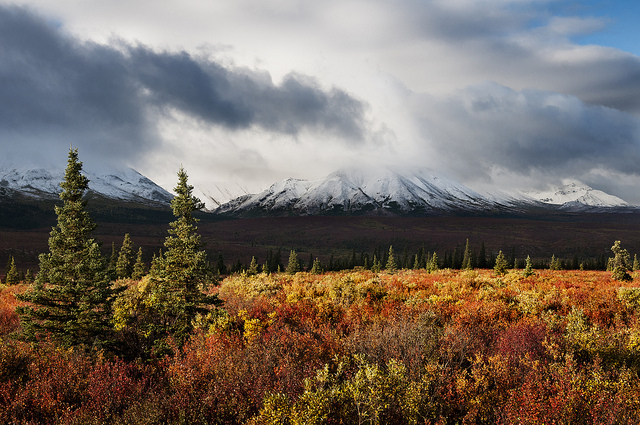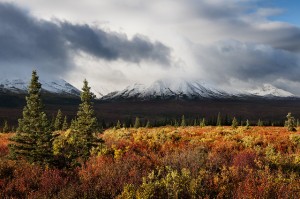
Changing climate, changing landscape: monitoring the vast wilderness of interior Alaska

Reds and golds of Fall. Broadleaf shrubs flame around the ever-green of conifers in the Toklat basin ecoregion of Denali National Park. Credit, Tim Rains, Denali National Park and Preserve, 2011.
National Park Service plant ecologist Carl Roland lives in Alaska, where climate change is palpably present. Ecologists have predicted major landscape-scale changes in the future of the Alaskan interior, with a potential shift from the iconic black and white spruce boreal forest, to broadleaf trees, or even grasslands, through a combination of heat, drought, insect outbreaks, and more frequent wildfires.
But predicting the future is not simple, not when you’re talking about landscapes as large and varied as the Alaskan Interior.
Carl and his colleagues in the Alaska National Park Service’s Inventory and Monitoring program have established ongoing ecosystem assessment across the Central Alaska Network encompassing Denali, Wrangell-Saint Elias, and Yukon-Charley Rivers National Parks and Preserves.
They have just published the first chunk of data in the February issue ESA’s journal Ecological Monographs, reporting a decade of data from Denali on the distribution and abundance of southcentral Alaska’s six tree species. They established over 1000 permanent sample sites spread across 1.28 million hectares of the north side of the park, hiking into remote locations, scrambling rocky slopes and wading mountain ponds to reach randomized plots. Carl tells Liza Lester why he thinks white spruce may expand higher up mountain slopes and into thawing tundra, while the cold-loving black spruce might lose ground. He describes his efforts to make National Park Service data more accessible, and makes a plea for the complementarity of academic and government science.
Click over to ESA’s blog, EcoTone, for more photos and experimental detail. Read more about the science of Denali’s changing landscape on the NPS Alaska Regional Office website.
Landscape-scale patterns in tree occupancy and abundance in subarctic Alaska. (2013) Carl Albert Roland, Joshua H. Schmidt, and E. Fleur Nicklen. Ecological Monographs 83(1):19-48.
2 replies on “Changing climate, changing landscape: monitoring the vast wilderness of interior Alaska”
Leave a Reply
You must be logged in to post a comment.


Pingback:Changing climate, changing landscape: monitoring the vast wilderness of interior Alaska | EcoTone
Pingback:Ecologists reaching out #reachingoutsci | EcoTone